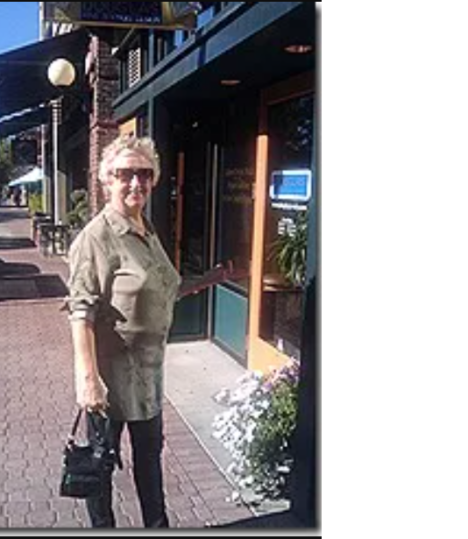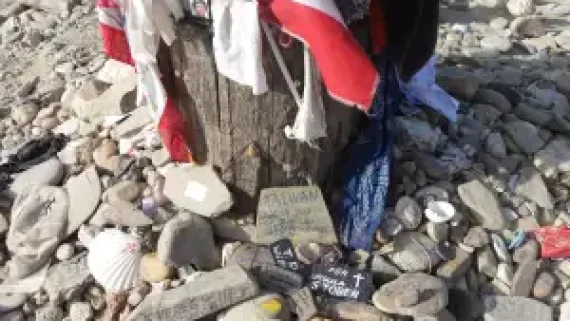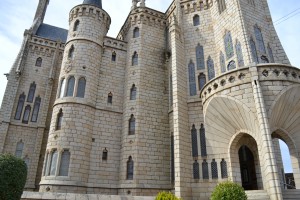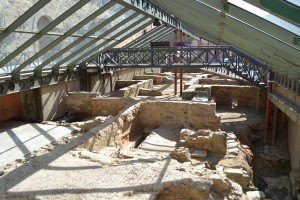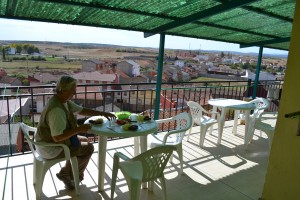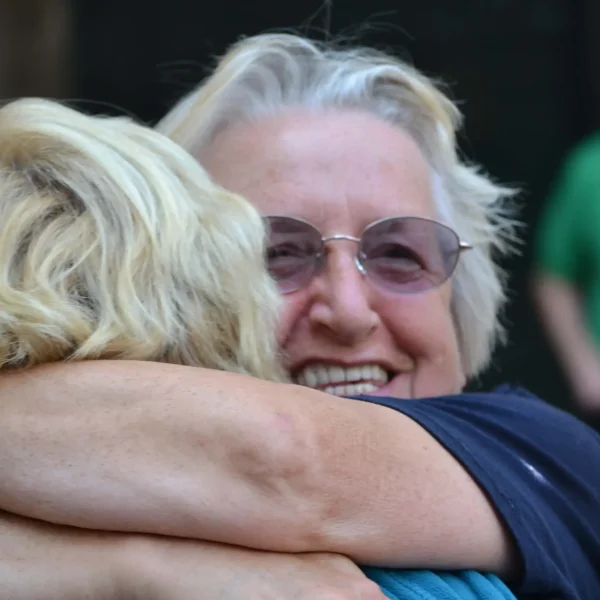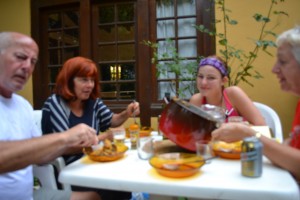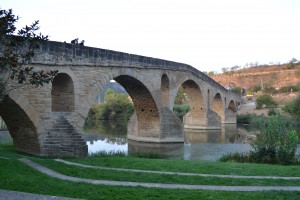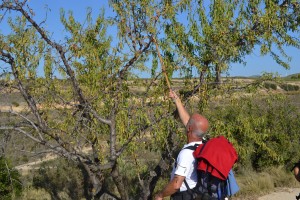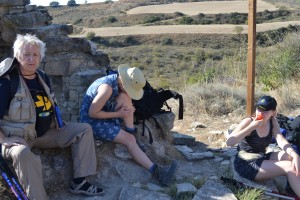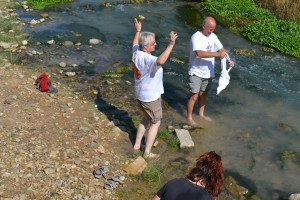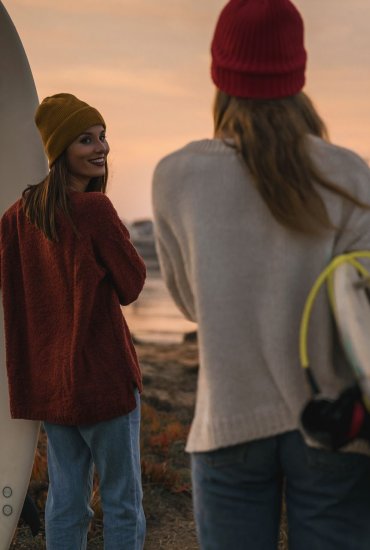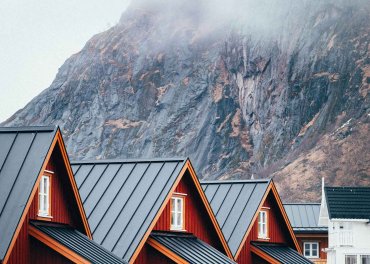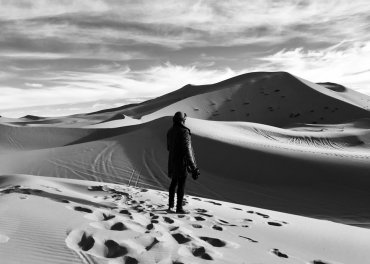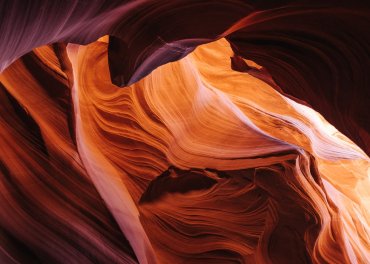Astorga to Rabanal del Camino, 22km.
Friday, October 7, 2011. I thought I’d have a solid night’s sleep, but I didn’t get to sleep until nearly 11, and between Mom’s snoring, Barbara’s (according to Mom), and apparently my own (per Carrie), the morning hours came far too quickly. Mom got up far earlier than we did, as is her wont, and went to the kitchen to make some German-style potatoes. She found the kitchen a disaster from the pilgrim revels of the night before (Mom thought “guitar-playing and drumming” would be too charitable, but there was strumming and banging involved). The kitchen was the classic tragedy of the commons, but, Mom being Mom, she cleaned it.
We were on the road at about 7:40a.m. It was cool, cool enough for two layers of Icebreaker wool. Unlike in days past, when, after 30 or 60 minutes I’d take off the top layer, I wore both layers the whole 22 kilometers. In fact, after my hands stopped functioning in any way but to hold my poles, I added gloves. And my five-toed socks. My nose ran the entire way, ran so hard and fast I feared it might reach Santiago without me.
Mom was pleased with the new Salomon trekking shoes she had bought yesterday. “Oh,” she

Mom's dancing in the shoe store blurs the shot
said. “I’m going to sleep in these!” For the first time since we began the Camino, she walked an entire stage in one pair of footwear, and did not resort to her sandals.
Even before we’d left Astorga, we came upon a wonderful aroma of fennel. It was like walking through a licorice factory. The blue of the dawning sky was beyond description. The power lines sizzled and buzzed overhead – something I’ve heard only in Spain. In Murias de Rechivaldo, we stopped for Second Breakfast at a small but cozy café run by a woman named Pilar. She addressed me as “senor,” and the bathrooms, to Mom’s delight, had both towels and soap, a rarity on the Road. (As long as I’m wearing wicking wool, I find towels unnecessary). These things would earn her a larger tip.
Pilar was playing Tibetan mantras on the stereo. “For patience,” she said, pronouncing it “pot-ience”. “And for compassion.”
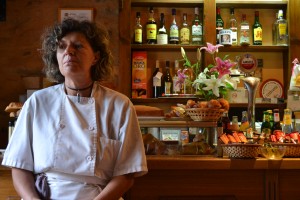
Senora Pilar
“There isn’t enough of that along the Road,” Mom said. Pilar agreed. They discussed Pilar’s liver problems, and her efforts to remain positive, and they shared tips on alternative medicine. Pilar said that good food had changed her life and her health — notably, she no longer ate jamon. Meanwhile, I talked with a Galician who has lived in Alberta for many years, his Canadian partner, and an Italian woman from Bologna.
The countryside between Astorga and Rabanal is sparsely populated. As the earth’s population climbs, I hope that people, especially those in China and India, will keep Spain in mind. The semi-arid terrain reminded me of the land in and around the Great Basin of the western United States: yellow grasses, light-green shrubs, heather, broom, wild
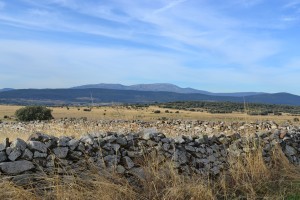
Stone corral
thyme, desert flowers, and a few types of dominant trees, none of them very tall, such as scrub oak. In the distance I saw a few copses of aspens.
It should have been no surprise to see a sign, in El Ganso, advertising a Cowboy Museum. (I couldn’t do it. Not after the chocolate museum). The soil was now red, too, reminding me that Colorado got its name from the Spanish – color red, color rado (red is now rojo in Spanish, but their explorers swept through the Colorado territory centuries ago).
We stopped for First Lunch in El Ganso and I took some notes and checked my email. Mom fed stray cats bread with butter – “Have you noticed they only eat it if it has butter on it?” – and the cats all ended up standing on my feet because she was throwing the crusts between them.
For the first time since before Burgos – that is, since far on the other side of the plains of Castilla and Leon – we saw walls made of stone. Some were in the fields, too large to have been a house, too small to enclose an entire property. I decided they must have been corrals for sheep and cows. The villages, too, were made of stone. Roofs were made of mined slate or even thatch. In the distance, hills, the ridgelines of which were covered with modern windmills too large for Don Quixote to tilt at.
We came upon a tree under which a young man in long curly hair had set up a table. He had been to Santiago and was now making his way back . . . to somewhere. For a donation, he was offering coffee, chai, hummus, and cake. Nearby, and much more alluringly, a slender, raven-haired woman played a haunting flying-saucer-like
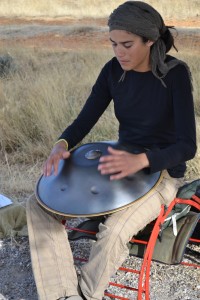
Spanish woman plays a hang in the middle of nowhere
instrument called a hang. Invented by a Swiss, it had small dimples spaced around its perimeter, and by tapping the places in between, she caused it to make different notes. The sound wasn’t too unlike the music played by the alien ship in “Close Encounters of the Third Kind”. Hank, a young Dutchman, tried his hand at it, too. I bought one of the woman’s CDs, and we moved on.
Hank and I walked for a while. He told me about a man who was on the Camino with his daughter’s ashes, and who was walking an astonishing 75 kilometers per day.
He told me he himself was on the Camino to prove, as he put it, “that I can finish something.” Shin splints had resulted in his early departure from the army, and his confidence had suffered.
“You thought something was wrong with you?” I said. “You worried that it wasn’t just the injury but that you were weak?”
“Something just like that,” he said. He was now traveling the world for a year, and filming his exploits. He said he wanted to learn how to meditate, and for about an hour I talked to him about it. Hank is probably the first person I’ve ever heard say, of English, “I love the language.”
“Why?”
“It’s just so easy and smooth. Dutch is like German, they both sound so harsh.”
“To my ear,” I said, “Dutch sounds a little like German, but also a little like English, so in the end it sounds like the kind of language I would make up, if I were going to make up a language that sounded like complete nonsense.”
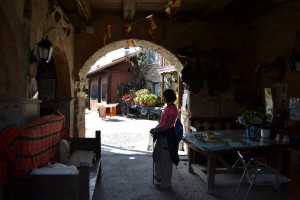
Rabanal Albergue entrada
Rabanal
The albergue in Rabanal was utterly charming. Stone walls, wooden beams, an outdoor bar and patio, flowers and flowering bushes scattered about. There’s even a mistletoe tree, about twelve feet tall. I thought mistletoe grew only at Christmas, and near doorways. The proprietress didn’t speak a lick of English, or anything other than Spanish, but she was all smiles, as was her mother, who must have been in her eighties. The daughter, who was in her late fifties, walked through the dorm and would cry Hola!, and Mom and I answered a few times, until we realized that she was playing peek-a-boo with pilgrims sitting outside the windows.
Once I’d dropped my pack I headed to the restroom. The light switch was not in the same room as the toilet stall. That should have been my first warning. Sure enough, after a few minutes of contemplation, I was cast into darkness. This saves on electricity, but it necessitates the use of more paper. I need to research how the Spanish are apparently able to do their business so quickly. Is it all the oil in their diet?
Mom sat down at a table next to Barbara, the Bavarian woman, and Rainer, from
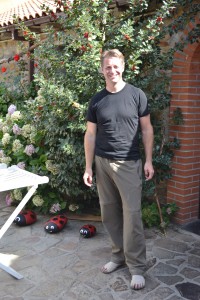
Okay, girls, this is a whole mistletoe tree. You know what to do.
Cologne. He’d had a hard day of walking, he said, after having had too much of a local spirit. Rainer said he was on the Camino because he’d had a rough two to three years, and he wanted to stop thinking about all his problems.
“Is it working?” I asked. He shrugged.
Barbara had beaten cancer four years earlier. She initially wanted to walk the Camino in order to spend some time by herself, but now, she said, she was feeling dankbarkeit, thankfulness or gratitude, for her life. While away from her normal life, she realized how good she had it. She had been married 26 years and she and her husband still felt about one another as they had when they met. She had wonderful daughters. She wanted everything, she said, to stay just the same. There, I thought, was a dangerous thought to attach oneself to.
Atop the iglesias in Rabanal, the little churches, were more storks’ nests. One of them, inside, was crumbling and rustic — perfect. We went there for a Vespers mass, blessedly short, and attempted, in Latin, that odd reading/singing-without-a-clear-melody that Catholics are somehow able to do, perhaps right out of the womb. We read a Psalm about the Lord crushing our enemies, and then we read from Romans about always doing things to please our neighbors.
“You did that really well,” Mom said to me. “Like you’ve done it before. But that priest was not going to let you be lead singer, no way.”
As we exited the church, another group of worshippers was waiting outside. Two women looked at my footwear aghast, as if I’d just walked across the face of the Lord, stopped, backed up, and wiped my feet. Soon the whole group had turned to watch me walking away, for all I know clutching their rosaries and crossing themselves. It’s this sort of thing that could make even a sociopath self-conscious.
Across a narrow road from a hotel that had wi-fi, I sat down with my computer in the cold. Vodafone charges me by the gigabyte, so when I want to upload pictures to Facebook or the blog, I use free wi-fi. A cat sat across the road from me, near the door of the restaurant. We exchanged a knowing glance, we two scavengers.
Morning in Rabanal del Camino: An Ode to My Fellow Pilgrims
It must have gotten into the 30s last night. Even with a blanket and two layers of clothes, I was cold. There was very little snoring, at least that I heard. I call this a miracle, and credit St. James himself. Mom said Rainer was sawing away because he’d drunk two bottles of wine the night before. In the morning he was nursing both a café con leche, from the bar and, in his left hand, a Coke. He said he felt awful and didn’t know why.
“Alcohol?” I said.
“Could be,” he said.
Although we’re no longer at risk of walking in hot weather, at this altitude and with current weather reports, pilgrims continue to insist on going to bed before 10 and getting up before 7a.m. to begin walking. And thus begins the second movement of each night’s Orchestral Maneuvers in the Dark (shout out to Yuka for the 80s reference). At first, one tentative soul glides around, quiet as can be. He is soon joined by another pilgrim or two. There is rustling, but it’s tentative.
But then the broken-window phenomenon sets in. With each new person, and each new noise, comes more permission for the next person to be louder. Soon the rustling turns into a manic stuffing, and then a loud zipping, and sotto voce voices turn into whispers fit for artillerymen, and eventually, no matter how many bleary-eyed people are still enclosed in sleeping bags, pilgrims are now calling out to one another, stomping about, slamming
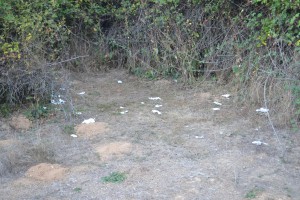
These are externalized costs, in economist-speak.
doors. It’s truly amazing that these are the same seemingly normal, well-adjusted people we have met the night before. Then again, once on the trail, some of them will also be unable to bury, or even to lift a rock to cover up, their used toilet paper.
I’m used to a wilderness ethic, at least in America, that says you pack out whatever you bring in. In true wilderness areas, that even includes your own waste. That’s what plastic bags are for. The Camino, by contrast, needs either to educate pilgrims better or to provide trash cans. Pilgrims disrespect their fellows, the locals, and the environment with their trash.
Tomorrow, we will finally reach the Cruz de Ferro, the highest point on the Camino and, by tradition, the place where pilgrims leave something behind — where they let go of something. It is probably the most important part of the Camino for Mom. “I’m going to leave my cancer there,” she said, a few months ago. But will she? And isn’t the hope itself dangerous?
